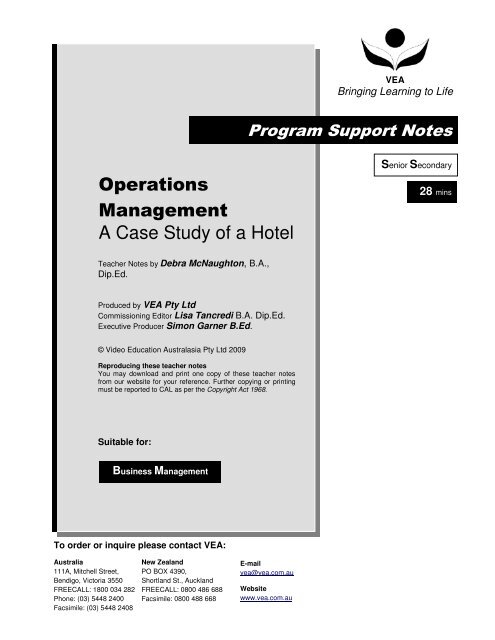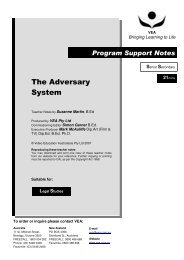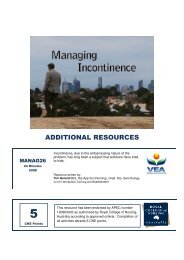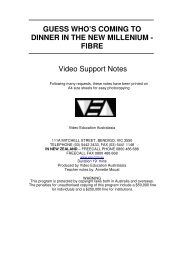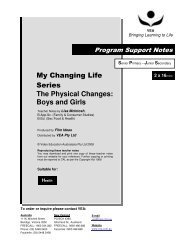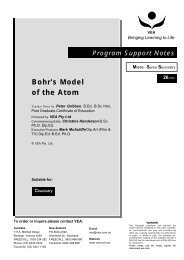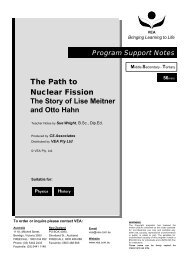Operations Management A Case Study of a Hotel - VEA
Operations Management A Case Study of a Hotel - VEA
Operations Management A Case Study of a Hotel - VEA
Create successful ePaper yourself
Turn your PDF publications into a flip-book with our unique Google optimized e-Paper software.
Australia<br />
111A, Mitchell Street,<br />
Bendigo, Victoria 3550<br />
FREECALL: 1800 034 282<br />
Phone: (03) 5448 2400<br />
Facsimile: (03) 5448 2408<br />
<strong>Operations</strong><br />
<strong>Management</strong><br />
A <strong>Case</strong> <strong>Study</strong> <strong>of</strong> a <strong>Hotel</strong><br />
Teacher Notes by Debra McNaughton, B.A.,<br />
Dip.Ed.<br />
Produced by <strong>VEA</strong> Pty Ltd<br />
Commissioning Editor Lisa Tancredi B.A. Dip.Ed.<br />
Executive Producer Simon Garner B.Ed.<br />
© Video Education Australasia Pty Ltd 2009<br />
Reproducing these teacher notes<br />
You may download and print one copy <strong>of</strong> these teacher notes<br />
from our website for your reference. Further copying or printing<br />
must be reported to CAL as per the Copyright Act 1968.<br />
Suitable for:<br />
Business <strong>Management</strong><br />
To order or inquire please contact <strong>VEA</strong>:<br />
New Zealand<br />
PO BOX 4390,<br />
Shortland St., Auckland<br />
FREECALL: 0800 486 688<br />
Facsimile: 0800 488 668<br />
E-mail<br />
vea@vea.com.au<br />
Website<br />
www.vea.com.au<br />
<strong>VEA</strong><br />
Bringing Learning to Life<br />
Program Support Notes<br />
Senior Secondary<br />
28 mins
For Teachers:<br />
Introduction<br />
<strong>Operations</strong> <strong>Management</strong> – A <strong>Case</strong> <strong>Study</strong> <strong>of</strong> a <strong>Hotel</strong><br />
The provision <strong>of</strong> accommodation is a highly competitive market. As tourists look for the best possible<br />
value for money, hotel operators must ensure that they are providing a quality venue with costeffective<br />
services. This program is based on the Mercure <strong>Hotel</strong> in Hobart and covers the key elements<br />
<strong>of</strong> its operations (the inputs and processes that create the output). The program examines the ways in<br />
which the design <strong>of</strong> its facility, the control <strong>of</strong> materials, the use <strong>of</strong> technology and the quality standards<br />
all contribute to ensuring the hotel remains productive and competitive.<br />
Program Timeline<br />
00:00:00 Introduction<br />
00:01:15 The basics <strong>of</strong> operations management<br />
00:05:13 Introducing four strategies<br />
00:10:17 Applying the four strategies<br />
00:14:56 Applying the four strategies (part two)<br />
00:20:10 Evaluating operations management<br />
00:26:20 Conclusion<br />
00:26:47 Credits<br />
00:27:37 End program<br />
Website References<br />
http://www.buseco.monash.edu.au/mkt/dictionary/<br />
http://www.ami.org.au/<br />
http://www.lean.org.au/<br />
Other Relevant Programs available from <strong>VEA</strong><br />
• Small Business <strong>Management</strong> Series -The Business Plan<br />
• The Four P's <strong>of</strong> Marketing Strategies<br />
• Introducing <strong>Operations</strong> <strong>Management</strong> - <strong>Case</strong> <strong>Study</strong> Rip Curl<br />
Please visit our website for more relevant programs www.vea.com.au<br />
<strong>VEA</strong> – Bringing learning to life<br />
- 2 -<br />
© Video Education Australasia Pty Ltd 2009<br />
Reproducing these teacher notes<br />
You may download and print one copy <strong>of</strong> these teacher notes from our website for your reference. Further copying or printing must be<br />
reported to CAL as per the Copyright Act 1968.
<strong>Operations</strong> <strong>Management</strong> – A <strong>Case</strong> <strong>Study</strong> <strong>of</strong> a <strong>Hotel</strong><br />
Student Worksheet:<br />
Before Viewing the Program<br />
1. Define the following terms:<br />
a) Goods<br />
b) Inputs<br />
c) <strong>Operations</strong> <strong>Management</strong><br />
d) Outputs<br />
e) Processes<br />
f) Productivity<br />
g) Services<br />
- 3 -<br />
© Video Education Australasia Pty Ltd 2009<br />
Reproducing these teacher notes<br />
You may download and print one copy <strong>of</strong> these teacher notes from our website for your reference. Further copying or printing must be<br />
reported to CAL as per the Copyright Act 1968.
<strong>Operations</strong> <strong>Management</strong> – A <strong>Case</strong> <strong>Study</strong> <strong>of</strong> a <strong>Hotel</strong><br />
While Viewing the Program<br />
1. List two inputs.<br />
2. Name two processes.<br />
3. Name one output <strong>of</strong> a hotel.<br />
4. Why is the layout <strong>of</strong> facilities important in a hotel?<br />
5. What is a Master Production Schedule used for?<br />
6. How do hotels ensure they keep their star ratings?<br />
7. How can technology assist with quality checks?<br />
8. Explain the importance <strong>of</strong> storage, as part <strong>of</strong> the facilities design and layout, for a hotel.<br />
- 4 -<br />
© Video Education Australasia Pty Ltd 2009<br />
Reproducing these teacher notes<br />
You may download and print one copy <strong>of</strong> these teacher notes from our website for your reference. Further copying or printing must be<br />
reported to CAL as per the Copyright Act 1968.
<strong>Operations</strong> <strong>Management</strong> – A <strong>Case</strong> <strong>Study</strong> <strong>of</strong> a <strong>Hotel</strong><br />
9. Why is it important to establish good relationships with suppliers as part <strong>of</strong> materials management?<br />
10. What is a par level?<br />
11. List two things the Executive Housekeeper Suzie Kelly checks to ensure that quality standards are<br />
maintained.<br />
12. List two new technologies that hotels are expected to provide.<br />
13. List three Key Performance Indicators that can be used to evaluate the success <strong>of</strong> a hotel such as<br />
the Hobart Mercure.<br />
- 5 -<br />
© Video Education Australasia Pty Ltd 2009<br />
Reproducing these teacher notes<br />
You may download and print one copy <strong>of</strong> these teacher notes from our website for your reference. Further copying or printing must be<br />
reported to CAL as per the Copyright Act 1968.
<strong>Operations</strong> <strong>Management</strong> – A <strong>Case</strong> <strong>Study</strong> <strong>of</strong> a <strong>Hotel</strong><br />
After Viewing the Program<br />
<strong>Operations</strong> management case study<br />
Cathy Sinta and Tony Martino own and run a medium sized business called Delizia that makes fresh<br />
pasta. They supply supermarkets, and over the last ten years have established a loyal customer base.<br />
The pasta is made using fresh ingredients that are delivered straight to their factory in Benalla in<br />
Victoria. In the past some <strong>of</strong> the pasta lines were hand-made, but now machines make the pasta and<br />
even pack it into the plastic containers and boxes ready for delivery.<br />
Things started to change for Cathy and Tony when complaints started coming in stating that the pasta<br />
was dry and stale. Customers returned stock, demanding their money back. One <strong>of</strong> the large<br />
Supermarket chains has said that unless the next batch is up to scratch, it will find another supplier<br />
for its fresh pasta.<br />
1. List five inputs that are required to make the output <strong>of</strong> Delizia; i.e. the pasta.<br />
2. List three processes that are required to make the output <strong>of</strong> Delizia; i.e. the pasta.<br />
3. The operations manager at Delizia must work fast to find the source <strong>of</strong> this problem. Suggest ways<br />
in which improvements in the following areas could assist them to improve the pasta:<br />
a) Facility layout and design<br />
b) Materials management<br />
- 6 -<br />
© Video Education Australasia Pty Ltd 2009<br />
Reproducing these teacher notes<br />
You may download and print one copy <strong>of</strong> these teacher notes from our website for your reference. Further copying or printing must be<br />
reported to CAL as per the Copyright Act 1968.
<strong>Operations</strong> <strong>Management</strong> – A <strong>Case</strong> <strong>Study</strong> <strong>of</strong> a <strong>Hotel</strong><br />
c) The management <strong>of</strong> quality<br />
d) Technology<br />
4. Suggest two Key Performance Indicators (KPIs) that Cathy and Tony could use to determine if the<br />
problem <strong>of</strong> the dry pasta has been solved.<br />
- 7 -<br />
© Video Education Australasia Pty Ltd 2009<br />
Reproducing these teacher notes<br />
You may download and print one copy <strong>of</strong> these teacher notes from our website for your reference. Further copying or printing must be<br />
reported to CAL as per the Copyright Act 1968.
<strong>Operations</strong> <strong>Management</strong> – A <strong>Case</strong> <strong>Study</strong> <strong>of</strong> a <strong>Hotel</strong><br />
Suggested Student Responses<br />
Before Viewing the Program<br />
1. Define the following terms:<br />
a) Goods<br />
Products that are tangible can be stored for later use and the consumption can occur<br />
separately from the purchase.<br />
b) Inputs<br />
The resources that are necessary to make the product.<br />
c) <strong>Operations</strong> <strong>Management</strong><br />
The task <strong>of</strong> managing the process that transforms resources into finished goods and/or<br />
services.<br />
d) Outputs<br />
The finished products (either goods or services) that result when inputs have been<br />
processed.<br />
e) Processes<br />
The actions performed on the inputs to transform them into finished products.<br />
f) Productivity<br />
The amount <strong>of</strong> output per worker or set <strong>of</strong> resources per period <strong>of</strong> time.<br />
g) Services<br />
Products that are intangible, they cannot be stored and the consumption usually occurs<br />
with the purchase, meaning that the consumer is involved directly.<br />
- 8 -<br />
© Video Education Australasia Pty Ltd 2009<br />
Reproducing these teacher notes<br />
You may download and print one copy <strong>of</strong> these teacher notes from our website for your reference. Further copying or printing must be<br />
reported to CAL as per the Copyright Act 1968.
<strong>Operations</strong> <strong>Management</strong> – A <strong>Case</strong> <strong>Study</strong> <strong>of</strong> a <strong>Hotel</strong><br />
While Viewing the Program<br />
1. List two inputs.<br />
Inputs may include: furniture, linen, electricity, water, employees, fruit, vegies and meats for<br />
the kitchens, computers.<br />
2. Name two processes<br />
Processes include: cleaning rooms, making reservations, checking guests in and out <strong>of</strong> the<br />
hotel, room service delivery, organising functions.<br />
3. Name one output <strong>of</strong> a hotel.<br />
Outputs include the provision <strong>of</strong> the guest rooms, the food served in the restaurants, the<br />
provision <strong>of</strong> facilities for functions and conferences.<br />
4. Why is the layout <strong>of</strong> facilities important in a hotel?<br />
Facilities need to enhance efficiency in a hotel. For this reason the public areas, such as the<br />
lobby, need to be easily accessed by guests and reception must be near the entrance. The<br />
loading bays must be close to where the most frequently ordered stock needs to be placed. In<br />
hotels this is near the kitchens and cool fridge areas.<br />
5. What is a Master Production Schedule used for?<br />
The MPS forecasts sales and business activity, allowing a Materials Requirement Plan to be<br />
generated which will outline the resources that are required for the next time period.<br />
6. How do hotels ensure they keep their star ratings?<br />
<strong>Hotel</strong>s conduct regular internal quality checks and acquire feedback from customers to<br />
ensure that they keep their star ratings.<br />
7. How can technology assist with quality checks?<br />
Online questionnaires allow guests to provide feedback on the quality <strong>of</strong> the hotel.<br />
8. Explain the importance <strong>of</strong> storage, as part <strong>of</strong> the facilities design and layout, for a hotel.<br />
The kitchens in hotels order a great deal <strong>of</strong> perishable stock, therefore the storage system is<br />
essential to ensure that stock is kept in fridges, freezers or store cupboards that will prolong<br />
its usable condition. Wasted stock equals lost money in a business.<br />
9. Why is it important to establish good relationships with suppliers as part <strong>of</strong> materials management?<br />
If there is a good relationship with suppliers, then the quality <strong>of</strong> the goods or services can be<br />
guaranteed, they will meet unusual demands (such as the rock lobster example in the<br />
program), and lead times can be minimal.<br />
10. What is a par level?<br />
A par level refers to the minimum quantity <strong>of</strong> each item that hotel needs to have in stock at<br />
all times.<br />
11. List two things the Executive Housekeeper Suzie Kelly checks to ensure that quality standards are<br />
maintained.<br />
Any two <strong>of</strong> the following would be correct:<br />
Suzie Kelly checks that the laundry is washing and ironing guests’ laundry properly, towels<br />
and sheets are properly laundered, there is no mould or body hair in the bathroom, the<br />
mirrors and toilets are clean, the beds are made properly, the guest rooms are set up properly<br />
and the glasses and mugs are all clean.<br />
- 9 -<br />
© Video Education Australasia Pty Ltd 2009<br />
Reproducing these teacher notes<br />
You may download and print one copy <strong>of</strong> these teacher notes from our website for your reference. Further copying or printing must be<br />
reported to CAL as per the Copyright Act 1968.
<strong>Operations</strong> <strong>Management</strong> – A <strong>Case</strong> <strong>Study</strong> <strong>of</strong> a <strong>Hotel</strong><br />
12. List two new technologies that hotels are expected to provide.<br />
Any two <strong>of</strong> the following would be correct:<br />
<strong>Hotel</strong>s are expected to provide widescreen TVs, electronic display boards, wireless internet<br />
access, electronic call buttons, electronic lock systems and a pay movie system in rooms.<br />
13. List three Key Performance Indicators that can be used to evaluate the success <strong>of</strong> a hotel such as<br />
the Hobart Mercure.<br />
Any 3 <strong>of</strong> the following would be correct, or the students may think <strong>of</strong> any number <strong>of</strong> others<br />
that would also be correct.<br />
<strong>Hotel</strong>s could consider their operations to be successful if:<br />
• The room occupancy rate is high<br />
• Pr<strong>of</strong>it has increased<br />
• Market share has increased<br />
• The level <strong>of</strong> waste has decreased (especially in the area <strong>of</strong> perishable items in the<br />
kitchens)<br />
• Cash flow and turnover have increased<br />
- 10 -<br />
© Video Education Australasia Pty Ltd 2009<br />
Reproducing these teacher notes<br />
You may download and print one copy <strong>of</strong> these teacher notes from our website for your reference. Further copying or printing must be<br />
reported to CAL as per the Copyright Act 1968.
<strong>Operations</strong> <strong>Management</strong> – A <strong>Case</strong> <strong>Study</strong> <strong>of</strong> a <strong>Hotel</strong><br />
After Viewing the Program<br />
<strong>Operations</strong> management case study<br />
Cathy Sinta and Tony Martino own and run a medium sized business called Delizia that makes fresh<br />
pasta. They supply supermarkets, and over the last ten years have established a loyal customer base.<br />
The pasta is made using fresh ingredients that are delivered straight to their factory in Benalla in<br />
Victoria. In the past some <strong>of</strong> the pasta lines were hand-made, but now machines make the pasta and<br />
even pack it into the plastic containers and boxes ready for delivery.<br />
Things started to change for Cathy and Tony when complaints started coming in stating that the pasta<br />
was dry and stale. Customers returned stock, demanding their money back. One <strong>of</strong> the large<br />
Supermarket chains has said that unless the next batch is up to scratch, it will find another supplier<br />
for its fresh pasta.<br />
1. List five inputs that are required to make the output <strong>of</strong> Delizia; i.e. the pasta.<br />
Flour, eggs, water, the factory, the pasta-making machines, computers, employees,<br />
packaging materials, delivery trucks, electricity, cleaning materials.<br />
2. List three processes that are required to make the output <strong>of</strong> Delizia; i.e. the pasta.<br />
Mixing the pasta dough, cutting the pasta into the required shapes, cleaning the pastamaking<br />
machines, taking orders for pasta, packaging the pasta, developing new recipes.<br />
3. The operations manager at Delizia must work fast to find the source <strong>of</strong> this problem. Suggest<br />
ways in which improvements in the following areas could assist them to improve the pasta:<br />
a) Facility layout and design<br />
Perhaps the storage <strong>of</strong> the raw ingredients is causing them to deteriorate early, causing<br />
the dry and stale taste. Ensuring that refrigeration is sealed and running at the correct<br />
temperature, and that there is proper storage <strong>of</strong> the dry ingredients could assist with<br />
this.<br />
b) Materials management<br />
The problem could be that the resources (inputs) are not as good lately. If Delizia has<br />
changed suppliers, it would be worth testing the ingredients to see if they have the same<br />
properties as those when there were no complaints. Perhaps the stock is not being<br />
rotated properly, resulting in old stock sometimes being used. The systems <strong>of</strong> stock<br />
rotation could be examined to see if improvements need to be made.<br />
c) The management <strong>of</strong> quality<br />
If quality checks have not picked up this problem, then perhaps a more formal quality<br />
system could be introduced, such as a system based on Total Quality <strong>Management</strong>. By<br />
setting up teams <strong>of</strong> workers to look at the problem, concentrating on ensuring that every<br />
single stage <strong>of</strong> production is the best possible quality that it can be, and always striving<br />
to improve the quality, problems like this might become rarer.<br />
d) Technology<br />
Machines are use to both make the pasta and to pack it. The problem could be occurring<br />
at either <strong>of</strong> these stages. Thorough examination <strong>of</strong> the machinery, including cleaning and<br />
maintenance could prevent problems such as this from happening.<br />
4. Suggest two Key Performance Indicators (KPIs) that Cathy and Tony could use to determine if<br />
the problem <strong>of</strong> the dry pasta has been solved.<br />
Here are a few possible answers to this question:<br />
• If the number <strong>of</strong> repeat orders increases<br />
• If the number <strong>of</strong> returned products decreases<br />
• If there is a general increase in sales<br />
• If pr<strong>of</strong>it increases<br />
- 11 -<br />
© Video Education Australasia Pty Ltd 2009<br />
Reproducing these teacher notes<br />
You may download and print one copy <strong>of</strong> these teacher notes from our website for your reference. Further copying or printing must be<br />
reported to CAL as per the Copyright Act 1968.


